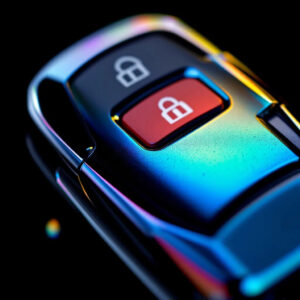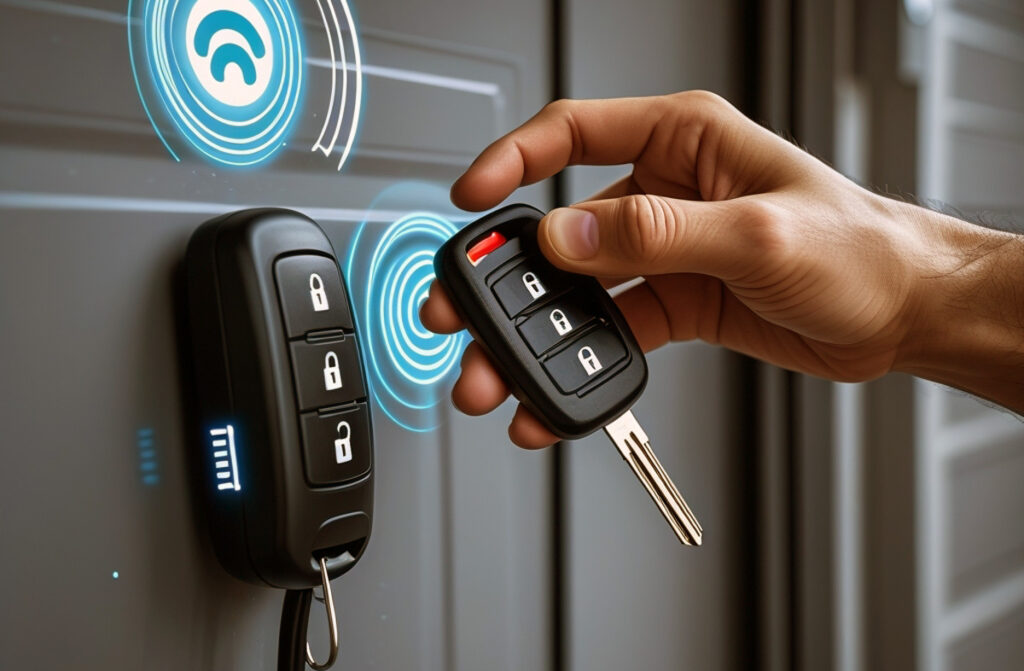If you press the garage button on your key fob or the in‑car remote and nothing happens, it is frustrating and a little unnerving. The door worked yesterday. The wall button still works. You changed the key fob battery not long ago. What gives? The short answer is that garage door openers and vehicle remotes depend on clean power, a reliable radio signal, and correct programming. If any one of those breaks down, the door may ignore you.
This guide explains the most common reasons a key fob or built‑in car remote fails to open a garage door, how to diagnose the problem quickly, and which fixes are worth trying before you call a professional.
Overview of how the system works
Most key fobs and in‑car systems like HomeLink send a short radio signal to the opener’s receiver. In North America many openers operate in the 300 to 400 MHz range, and modern units use rolling codes for security. Your car either transmits directly to the opener’s built‑in receiver or to an add‑on receiver module connected to the opener. If the receiver hears a valid code at a strong enough signal, it triggers the motor.
If the door does not respond, the fault is usually in one of five buckets:
-
the transmitter side in the vehicle
-
the opener’s radio receiver
-
interference-reducing signal strength
-
the opener’s safety or lock features
-
a basic power or hardware issue with the opener
Quick 60‑second checks
Start with fast, no‑tools checks. They often solve the problem.
• Try the wall button. If that fails too, you likely have a power or opener fault, not a remote problem.
• Stand inside the garage and press the remote a few feet from the opener’s antenna. If it works up close but not from the driveway, you have a range or interference issue.
• Look at the opener’s light and the wall console. If the wall console has a lock or vacation indicator lit, the opener is intentionally ignoring remotes. Unlock it.
• Make sure the GFCI or breaker that feeds the opener has not tripped. Many garages share a GFCI with outlets.
• Confirm the garage door is not mechanically jammed. Pull the emergency release cord and move the door by hand. It should move smoothly and stay balanced about halfway up.
Common reasons on the vehicle side
-
Weak or incorrect key fob battery
Key fobs typically use coin cells like CR2032 or CR2025. As voltage sags, range falls off first. The remote may still lock your car since that receiver is closer and more sensitive, but the garage door might not hear it from the driveway. Replace the battery with the specified type and clean the contacts. -
HomeLink or built‑in remote lost programming
Battery disconnects, windshield replacements, a new opener, or a receiver memory wipe can break the pairing. Reprogram the in‑car transmitter. The quick version is usually: hold the remote in front of the HomeLink button, press both until the indicator flashes rapidly, then press the opener’s Learn button and return to the vehicle to press the programmed HomeLink button a couple of times. The exact steps vary by vehicle and opener, so follow the owner’s manuals. If your vehicle is older and your opener is a newer rolling‑code model, you may need a small bridge or repeater kit to make them talk to each other. -
Shielding or obstructions in the car
Metalized or athermic windshields, mirror housings with heavy electronics, and certain dash placements can attenuate radio signals. Try pressing the handheld remote outside the vehicle or hold it close to the windshield near the rear‑view mirror. If signal improves, windshield coating and interior obstructions are reducing range. -
Accessories generating noise in the cabin
Some cheap USB chargers, dash cams, radar detectors, and plug‑in accessories can spray radio noise. Unplug all accessories and test again. If range returns to normal, plug devices back in one by one to find the culprit.
Common reasons on the opener side

-
Vacation or lock mode is enabled.
Many wall consoles have a lock function that disables wireless remotes. On some models a small LED will indicate lock. Hold the lock button or follow the opener manual to toggle it off. -
Receiver antenna problem
Look for the thin dangling wire on the opener. It should hang straight down. If it is missing, broken, tucked into the cover, or coiled around metal, range will be poor. Carefully straighten it and keep it away from metal surfaces. -
LED bulb interference
Some non‑shielded LED bulbs create radio interference. This can severely cut remote range or block the signal entirely. Replace the opener light bulbs with “garage door opener compatible” bulbs or known low‑interference LEDs. If range improves immediately, you have found the issue. -
Frequency or protocol mismatch
Older remotes do not talk to newer tri‑band or rolling‑code openers, and vice versa. If you replaced the opener or remote recently, verify compatibility. In some cases you can add a universal external receiver to the opener to restore compatibility without replacing remotes. -
Memory full or codes cleared
Openers can store only a limited number of remotes and in‑car buttons. If memory is full, new pairings will fail. Clear and reprogram. Be aware that clearing the memory removes all remotes, so plan to reprogram each one. -
Safety sensor or travel fault
Photo‑eyes near the floor are meant to block closing if the beam is interrupted. Most openers still allow opening with a blocked beam, but if wiring is damaged, sensors are misaligned, or the opener has a travel or force fault, it may ignore all radio commands. Check that both sensors are lit solid and aligned. Clean the lenses. If the door tries to move and reverses or clicks without moving, you may have a travel limit, force calibration, or hardware issue that needs service. -
Receiver board or power issues
Surge events, moisture, and age take a toll on the logic board and receiver. If you only get intermittent response, or if the wall button works but remotes are erratic even at close range with a known good antenna and bulbs, the receiver may be failing.
Radio interference sources you might not suspect
• LED shop lights and CFLs in the garage
• Nearby ham radio, CB, or heavy industrial equipment
• Electric vehicle chargers or inverters with noisy switching power supplies
• Neighbor’s opener using the same frequency and spewing interference through a faulty bulb or accessory
• Smart home hubs and wireless cameras near the opener power outlet
Try to isolate the opener from noisy devices. Plug it directly into the ceiling outlet without a surge strip, move smart devices a few feet away, and change lighting to known low‑interference bulbs.
Step‑by‑step troubleshooting flow
-
Confirm power and basic operation
Press the wall control. If the door runs normally, the motor and power are fine. If the motor does not run or only clicks, solve that first. Check the GFCI and breaker, then look for error lights or beeps. -
Check the wall console lock
If engaged, disable it. Many lock buttons require a three‑second hold. -
Test from close range
Stand on a ladder and press the remote near the opener’s antenna. If it works only within a few feet, the issue is range. Replace the fob battery, straighten the antenna, and swap LED bulbs. -
Replace the fob battery
Use the correct coin cell. Clean contact points and reassemble carefully. -
Reprogram the transmitter
Relearn your key fob or HomeLink using both the vehicle and opener instructions. If you see rapid flashing during programming but the opener never responds, check compatibility or consider a bridge module. -
Eliminate interference
Turn off or unplug nearby lights and accessories, especially new LED bulbs, chargers, and cameras. Test remotes again. If the problem disappears, replace the noisy device. -
Inspect safety sensors and wiring
Verify both sensor LEDs are solid and aligned. Clean the lenses and ensure the brackets are not bent. -
Consider hardware age and repair
If your opener is older and exhibits intermittent receiver issues after all of the above, the receiver board may be failing. At that stage, repair or replacement is more cost effective than more guesswork.
Vehicle programming notes
HomeLink and similar in‑car systems are convenient, but they are not set‑and‑forget forever. A few common events that trigger reprogramming:
• Vehicle battery disconnect or replacement
• Windshield replacement if the transmitter module lives in the mirror assembly
• New opener installation or logic board replacement
• Memory clear on the opener side
If you have an older vehicle and a newer Security+ 2.0 style opener, ask for a compatibility bridge. It is a small repeater that teaches the car an older code and translates to the newer opener.
When to call a professional
Call a pro if any of the following are true:
• The opener ignores remotes even at close range with a fresh battery and known good bulbs
• The wall button works but the door stops and reverses or chatters without moving
• You suspect a receiver board, travel limit, or spring issue
• You cleared the memory and cannot successfully reprogram the remotes
• You see frayed cables, bent track, broken springs, or hear loud pops
A qualified technician can test radio range, scan for interference, replace a failing receiver or logic board, align safety sensors, set travel limits and force, and advise whether garage door repair or replacement is the smarter long‑term move.
Helpful maintenance habits that prevent remote failures
• Replace key fob coin cells annually and keep a spare in the glove box
• Use low‑interference bulbs designed for garage door openers
• Keep the opener antenna straight and unobstructed
• Clean and align safety sensors when you sweep the garage
• Reprogram HomeLink after any electrical or glass work on the vehicle
• Lubricate rollers and hinges with the correct lubricant and keep tracks clean
Final thoughts
Your car’s key fob and built‑in remote rely on a clean radio handshake with the opener. If the door does not respond, do not assume you need a new opener or a new car transmitter. Work through the quick checks in order. Most problems end up being a weak fob battery, a wall console lock that is on, a noisy LED bulb, or HomeLink that needs to be reprogrammed. When those do not solve it, a technician can diagnose receiver issues, interference, and travel faults in a single visit, and make sure the door is safe and reliable.
